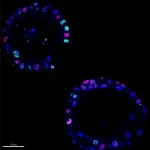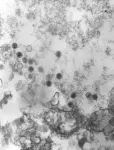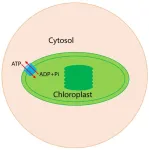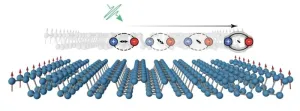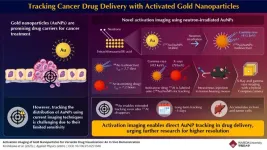(Press-News.org) Pancreatic cancer is one of the deadliest cancers worldwide, with a five-year survival rate of 13%. This poor prognosis stems from both late detection and the cancer’s notorious capacity to adapt and resist therapy. Now, a study led by researchers at the University of Verona, University of Glasgow, and the Botton-Champalimaud Pancreatic Cancer Centre uncovers a hidden driver of this adaptability: extrachromosomal DNA (ecDNA).
A New Player in Pancreatic Cancer
The team found that some pancreatic cancer cells gain a major survival edge by carrying copies of critical cancer genes—such as MYC—on circular pieces of DNA that exist outside chromosomes, the structures that house most of our genetic material. Known as ecDNA, these genetic rings float freely in the cell nucleus, enabling tumour cells to swiftly ramp up gene expression, change their shape, and survive in otherwise hostile environments.
“Pancreatic cancer is often called a silent killer because it’s hard to detect until it’s too late”, says Peter Bailey, co-corresponding author and Director of Translational Research at the Botton-Champalimaud Pancreatic Cancer Centre. “We know that part of its lethality arises from the ability of tumour cells to ‘shape shift’ under stress. Our study shows that ecDNA forms a big part of that story”.
The researchers discovered ecDNA to be surprisingly common in pancreatic tumours, particularly for oncogenes like MYC, which drives cancer growth and metabolism. “We saw far more variability in MYC copy number when MYC was on ecDNA”, explains Elena Fiorini, co-first author and senior postdoc. “Some cells carried dozens—or even hundreds—of extra MYC copies, giving them a large growth advantage under certain conditions”.
“It’s effectively a ‘bet-hedging’ strategy”, adds Daniel Schreyer, co-first author and former PhD student of the University of Glasgow. “You get pockets of cells that carry very high MYC levels, which is beneficial under certain conditions, and others with fewer copies, which might do better in another environment—all within the same tumour”.
Such flexibility underscores the profound intratumour heterogeneity characteristic of pancreatic cancer, where myriad sub-populations coexist and respond differently to treatment. Targeting one subset often fails against another, fueling resistance.
A key advantage of this study is that the organoids—mini-3D replicas of pancreatic tumours grown in the lab—were derived directly from patients with early-stage disease. These organoids preserve much of the genetic make-up of the original tumour, making them excellent testbeds for studying cancer. Unlike methods that artificially introduce ecDNA, these lab models reflect genuine ecDNA variants found in real tumours.
“This approach offers real-world insight into how dynamic and disordered a tumour can be”, says Fiorini. “We see firsthand that even when two patients both have MYC on ecDNA, the structure of that circular DNA can differ substantially—leading to big variations in MYC expression”.
Plasticity in Action: Organoids in the Lab
To see how ecDNA drives adaptation, the researchers grew patient-derived organoids and removed vital growth signals—such as WNT factors—and then observed how these organoids responded to the stress.
“We found that organoids bearing MYC on extrachromosomal DNA could shift their dependency on WNT”, explains Antonia Malinova, co-first author and a former PhD student at the University of Verona. “Essentially, cells with high levels of ecDNA became more self-sufficient, no longer needing those external signals to survive”.
The study also revealed a clear link between high MYC levels and changes in tumour cell shape and behaviour. When MYC ecDNA levels soared, cells morphed into more aggressive, solid structures—losing their more organised, gland-like architecture.
“What’s remarkable”, says co-corresponding author Vincenzo Corbo from the University of Verona, “is how rapidly these ecDNA-based copies can appear or disappear depending on the environment. If the cancer is under pressure—say, lacking key growth factors—cells with ecDNA can crank up MYC expression to survive. But if that pressure lifts, they can lose some of these extra DNA circles to avoid the downsides of carrying too many copies”.
Indeed, expressing MYC at high levels can trigger DNA damage, forcing cancer cells to carefully balance the costs and benefits of ecDNA retention. “That was unexpected”, says Corbo. “It challenges the assumption that more MYC is always better for a cancer cell—there’s a real fitness cost to maintaining such high levels”.
ecDNA as a Therapeutic Target?
Although extrachromosomal DNA only appears in about 15% of patient samples in this study, that subset might be particularly aggressive or prone to therapy resistance. As a result, detecting or disrupting ecDNA could open new therapeutic windows.
“We might imagine a strategy that exploits the vulnerabilities introduced by ecDNA”, notes Corbo. “Perhaps pushing cancer cells to dial MYC up to a point where they can’t handle the DNA damage, or blocking the molecular circuits that maintain these DNA rings so cells lose them altogether”.
However, the authors caution that such ideas remain early-stage. “ecDNA is a double-edged sword—helpful for quick adaptation but costly to maintain”, says Corbo. “The challenge is to tip that balance in favour of the patient”.
Crucially, this work broadens our understanding of genomic plasticity—challenging the notion that the genome is always “fixed”. “We knew the tumour’s surroundings could drive changes, but not that WNT signalling could so directly rewrite DNA”, Bailey adds. “We assumed we’d see mostly epigenetic shifts, so seeing this level of genomic re-engineering was definitely a surprise”.
And with pancreatic cancer cases projected to rise in the coming years, insights into ecDNA’s role could guide future strategies to intercept or exploit this genetic feature—potentially making tumours more vulnerable to treatment.
END
The secret DNA circles fueling pancreatic cancer’s aggression
2025-03-12
ELSE PRESS RELEASES FROM THIS DATE:
2D metals: Chinese scientists achieve breakthrough in atomic manufacturing
2025-03-12
Since the groundbreaking discovery of graphene in 2004, the dizzying pace of progress in two-dimensional (2D) materials has ushered in a new era of fundamental research and technological innovation. Although nearly 2,000 2D materials have been theoretically predicted and hundreds have been created in laboratory settings, most of these 2D materials are limited to van der Waals (vdW) layered crystals.
Scientists have long been keen to develop atomically thin 2D metals, thereby expanding ...
Cause of post-COVID inflammatory shock in children identified
2025-03-12
MIS-C is a serious inflammatory shock that affects children. It can occur several weeks after a COVID infection and can be life-threatening. Until now, however, the precise cause of the condition was unknown. Researchers at Charité – Universitätsmedizin Berlin and the German Rheumatology Research Center (DRFZ), an institute of the Leibniz Association, have identified that reactivation of a pre-existing, dormant infection with the Epstein-Barr virus triggers an excessive inflammatory response. The researchers have detailed their findings in an article in Nature.* These insights open the door to new treatment methods, potentially not limited to MIS-C.
The majority of children ...
QIA researchers create first Operating System for Quantum Networks
2025-03-12
Delft, The Netherlands: Quantum Internet Alliance (QIA) researchers at TU Delft, QuTech, University of Innsbruck, INRIA and CNRS recently announced the creation of the first operating system designed for quantum networks: QNodeOS. The research, published in Nature, marks a major step forward in transforming quantum networking from a theoretical concept to a practical technology that could revolutionize the future of the internet.
“The goal of our research is to bring quantum network technology to all. With QNodeOS we're taking a big step forward. We're making it possible – ...
How the brain uses ‘building blocks’ to navigate social interactions
2025-03-12
Our brains use basic ‘building blocks’ of information to keep track of how people interact, enabling us to navigate complex social interactions, finds a new study led by University College London (UCL) researchers.
For the study, published in Nature, the researchers scanned the brains of participants who were playing a simple game involving a teammate and two opponents, to see how their brains were able to keep track of information about the group of players.
The scientists found that rather ...
Want to preserve biodiversity? Go big, U-M researchers say
2025-03-12
ANN ARBOR—Large, undisturbed forests are better for harboring biodiversity than fragmented landscapes, according to University of Michigan research.
Ecologists agree that habitat loss and the fragmentation of forests reduces biodiversity in the remaining fragments. But ecologists don't agree whether it's better to focus on preserving many smaller, fragmented tracts of land or larger, continuous landscapes. The study, published in Nature and led by U-M ecologist Thiago Gonçalves-Souza, comes to a conclusion on the decades-long debate.
"Fragmentation is bad," said study author Nate Sanders, U-M professor of ecology and evolutionary biology. ...
Ultra-broadband photonic chip boosts optical signals
2025-03-12
Modern communication networks rely on optical signals to transfer vast amounts of data. But just like a weak radio signal, these optical signals need to be amplified to travel long distances without losing information. The most common amplifiers, erbium-doped fiber amplifiers (EDFAs), have served this purpose for decades, enabling longer transmission distances without the need for frequent signal regeneration. However, they operate within a limited spectral bandwidth, restricting the expansion of optical networks.
To meet the growing demand for high-speed data transmission, researchers have been seeking ways to develop more powerful, flexible, ...
Chinese scientists explain energy transfer mechanism in chloroplasts and its evolution
2025-03-12
A recent study by Chinese scientists has revealed the intricate molecular machinery driving energy exchange within chloroplasts, shedding light on a key event in the evolution of plant life. Led by FAN Minrui from the Center for Excellence in Molecular Plant Sciences of the Chinese Academy of Sciences, the research elucidates the structure and function of the ATP/ADP translocator—a crucial member of the nucleotide transporter (NTT) family of proteins—which facilitates the transfer of energy across chloroplast membranes.
Their findings were published online in ...
Exciting moments on the edge
2025-03-12
Scientists have long suspected that phosphorene nanoribbons (PNRs) – thin pieces of black phosphorus, only a few nanometres wide – might exhibit unique magnetic and semiconducting properties, but proving this has been difficult. In a recent study published in Nature, researchers focused on exploring the potential for magnetic and semiconducting characteristics of these nanoribbons. Using techniques such as ultrafast magneto-optical spectroscopy and electron paramagnetic resonance they were able to demonstrate the magnetic behaviour of PNRs at room temperature, and show how these magnetic properties can interact with light.
The ...
MD Anderson Research Highlights for March 12, 2025
2025-03-12
HOUSTON ― The University of Texas MD Anderson Cancer Center’s Research Highlights showcases the latest breakthroughs in cancer care, research and prevention. These advances are made possible through seamless collaboration between MD Anderson’s world-leading clinicians and scientists, bringing discoveries from the lab to the clinic and back.
Study offers insights into evolutionary process driving pancreatic cancer
Read summary | Read study in Nature
Pancreatic cancer is hard to treat because ...
Lighting the way: how activated gold reveals drug movement in the body
2025-03-12
Gold nanoparticles (AuNPs) are tiny gold particles of 1–100 nanometers and have unique chemical and biological properties. Due to their potential to accumulate in tumors, these nanoparticles have emerged as promising drug carriers for cancer therapy and targeted drug delivery. However, tracking the movement of these nanoparticles in the body has been a major challenge. Traditional imaging methods often involve tracers like fluorescent dyes and radioisotopes, which give limited visualization and inaccurate results due to detachment from AuNPs.
In a step to advance the imaging of AuNPs, researchers from Waseda ...
